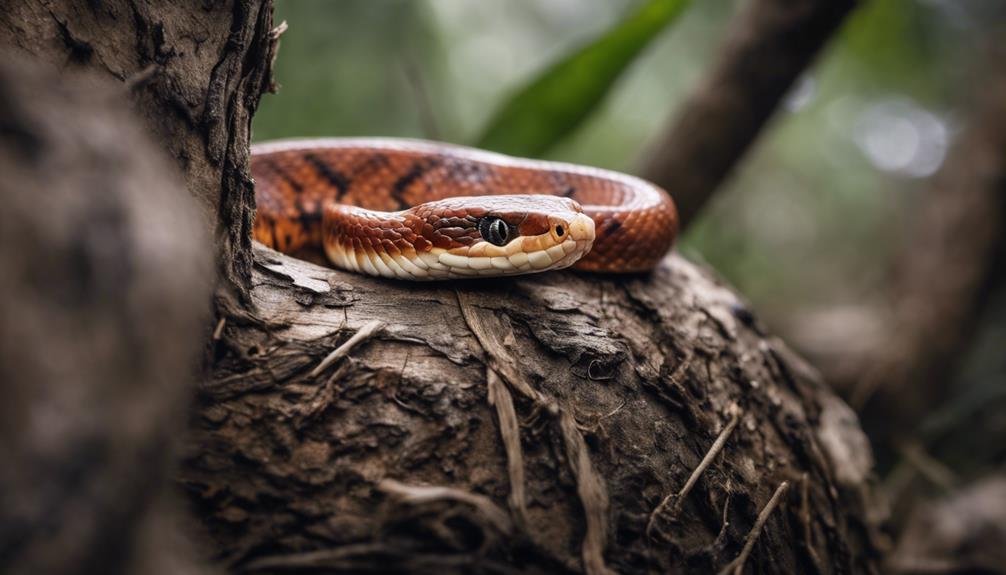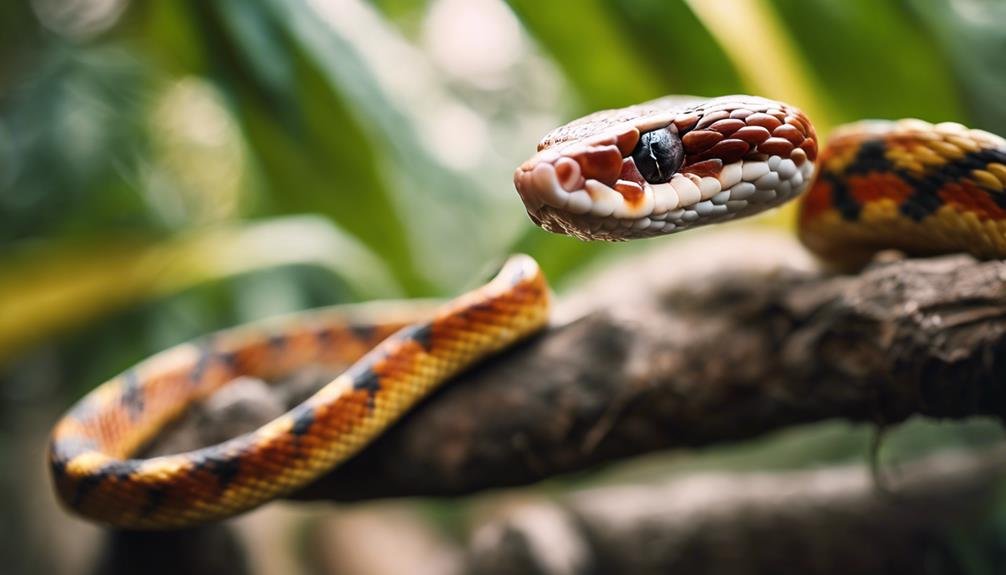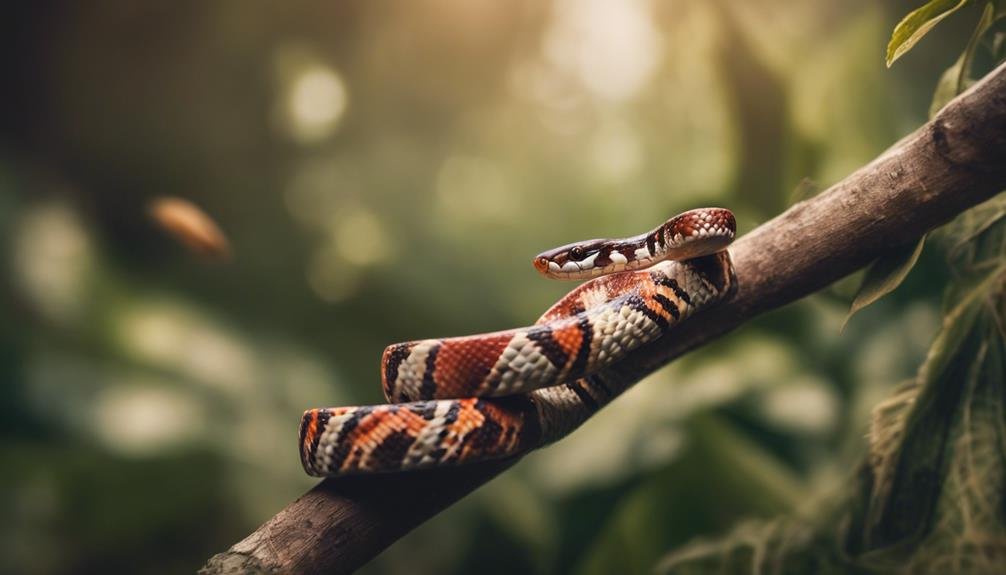You've probably noticed how effortlessly corn snakes ascend, weaving through branches with a grace that belies their earthbound origins. But have you ever paused to wonder why they climb? Is it a simple matter of survival, a strategic move to evade predators, or is there more to this behavior? Consider the possibility that these reptiles climb not just out of necessity but also for sheer enjoyment. The answer might surprise you and shed light on the complex nature of these fascinating creatures. Let's explore this intriguing aspect of corn snake behavior together and uncover what truly motivates their arboreal adventures.
Key Takeaways
- Corn snakes climb to evade predators, utilizing their natural arboreal skills for survival.
- Climbing satisfies their curiosity and provides necessary mental and physical stimulation.
- The behavior enhances their hunting strategies, allowing them to ambush prey effectively.
- It allows them to explore and interact with their environment, mimicking natural instincts.
- While climbing has practical purposes for survival, it also offers fun and enrichment in their daily lives.
Natural Climbing Abilities
Corn snakes naturally climb to explore and engage with their environment, showcasing their innate arboreal skills. When you observe a corn snake, it's clear they love to climb. This isn't just for show; climbing is a critical part of their physical and mental health. It offers them the stimulation they need, mimicking their natural habitats and behaviors.
Imagine your corn snake's vivarium without any stuff to climb on – it would be like a birdcage without perches, limiting their ability to express natural behaviors. By introducing climbing structures like branches and creating a mix of vertical and horizontal spaces, you're not just decorating their space; you're enriching their lives.
Some corn snakes might show more enthusiasm for climbing than others, and that's okay. It's about giving them the option. Watch them as they navigate their environment, gracefully moving up and down. You'll see their love to climb isn't just about reaching a higher spot; it's about exploring, staying active, and satisfying their curiosity.
Escaping Predators
You've seen how corn snakes are natural climbers, but have you considered why they've developed this skill?
It's primarily to evade predators, using their agility to climb to safety where threats can't easily follow.
This instinctual behavior not only showcases their climbing abilities but is a vital survival strategy in the wild.
Predator Evasion Strategies
To evade predators, corn snakes employ their climbing skills, seeking higher ground where they're safer and more secure. This climbing behavior isn't just for show; it's a critical predator evasion tactic.
By taking to the trees or scaling rocky outcrops, they can escape threats lurking on the ground. It's their natural defense mechanism in action, allowing them to quickly retreat to spots out of predators' reach.
This isn't a skill they've learned on a whim—it's deeply ingrained in their behavior, a survival instinct that aids in their longevity in the wild.
Natural Climbing Abilities
Harnessing their natural climbing abilities, corn snakes adeptly escape predators by ascending to safer heights where ground threats can't reach them. This climbing behavior isn't just a casual activity; it's an instinctual response deeply embedded in their survival strategy.
By moving upwards, they tap into a fundamental defense mechanism, ensuring they stay out of harm's way. Their adept climbing skills are essential, allowing them to swiftly evade ground-dwelling predators that pose a significant threat.
This instinctual drive to climb and reach higher ground doesn't just offer a momentary refuge but is necessary for their survival. Climbing, for corn snakes, is more than a skill—it's a necessary tactic for safety, making their ability to ascend not just impressive but crucial.
Hunting Strategies


Corn snakes elevate their hunting game by climbing, allowing them to ambush prey from above with surprising efficiency. This isn't just a random behavior; it's a calculated part of their hunting strategies. When they ascend trees or shrubs, they're not just getting a better view. They're positioning themselves to blend in with their surroundings, becoming nearly indistinguishable from branches or foliage. This camouflage isn't just for show. It's a deadly tactic that lets them strike at unsuspecting prey that wanders too close.
The benefits of this approach are twofold. First, by taking the high ground, corn snakes access a wider range of prey items, from birds in nests to insects that other ground-dwelling predators might miss. This versatility in diet makes them more resilient as a species. Additionally, their ability to mimic their environment and ambush prey speaks to their adaptability and intelligence as hunters. They're not just climbing for the sake of it; they're using their natural abilities to secure a meal in the most effective way possible.
Exploring Their Habitat
As you explore why corn snakes climb, it's important to understand their natural climbing instincts and the complexity of their habitat needs.
These snakes utilize vertical space in their enclosures to mimic their natural environment, which is vital to their health and behavior.
Natural Climbing Instincts
To satisfy their natural instincts, corn snakes often climb to explore their habitat, engaging in this activity not just for survival but for enjoyment as well. Their climbing behavior showcases a blend of exploration and fun, underpinning their need to engage in natural behaviors. Offering them vertical structures like branches allows these snakes to express their arboreal tendencies, adding enrichment to their lives.
| Aspect of Climbing | Why It Matters |
|---|---|
| Exploration | Corn snakes actively seek out new areas, enhancing their environment. |
| Enrichment | Climbing provides mental and physical stimulation. |
| Arboreal Tendencies | Vertical structures mimic their natural inclination for climbing. |
| Natural Behaviors | Engaging in climbing fulfills their instinctual needs for exploration and fun. |
Habitat Complexity Needs
Understanding the intricacies of their habitat is essential for corn snakes, as they frequently climb to satisfy their curiosity and natural instincts. Providing climbing structures in their vivariums isn't just about decoration; it's about catering to their habitat complexity needs.
By integrating vertical spaces and branches, you're not only enhancing their quality of life but also allowing them to exhibit natural behaviors. This isn't just speculation; numerous discussions on forums dedicated to reptile care underscore the significance of such habitat complexity.
Climbing offers both physical and mental stimulation, which is vital for their overall well-being. It's a form of exercise and enrichment that encourages them to explore, keeping their minds and bodies active and healthy.
Vertical Space Utilization
Corn snakes actively climb to explore and utilize the vertical space in their habitats, engaging in a vital aspect of their natural behavior. This climbing isn't just for show; it allows them to exercise essential behaviors such as exploring and surveying their surroundings, important for their mental and physical health.
Within the community, enthusiasts often share on forums how vertical space utilization enriches the snake's environment, promoting mental stimulation and physical activity. By offering climbing opportunities, you're supporting the well-being of corn snakes, providing a diverse and engaging living space.
Elevated resting spots mimic their natural habitat, where they may perch on branches, showcasing the importance of climbing in their daily lives. It's clear, climbing is more than a pastime; it's a necessity.
Physical Exercise Benefits
Engaging in climbing activities, corn snakes receive essential physical exercise that supports their health and well-being. This isn't just about staying active; it's about thriving. Each climb allows your corn snake to stretch and strengthen its muscles, greatly improving agility and coordination. Think of it as their form of a workout routine, ensuring they stay in top shape.
But the exercise benefits don't stop at physical health. Climbing is also an important source of mental stimulation for these curious creatures. It keeps their mind sharp and engaged, preventing the boredom that often plagues captive animals. This mental workout is as important as the physical one, ensuring your corn snake remains lively and alert.
Moreover, climbing acts as a natural shedding aid. The act of rubbing against rough surfaces while climbing facilitates the shedding process, making it smoother and less stressful for your snake. This not only helps in maintaining healthy skin but also mimics the natural behaviors they'd exhibit in the wild, adding an enrichment layer to their captivity life.
Incorporating climbing opportunities in your corn snake's enclosure is more than just fun; it's a holistic approach to their overall care, covering exercise benefits, mental stimulation, and aiding in shedding.
Do Corn Snakes Climb as a Means of Evading Capture, or Just for Fun, Similar to How They Swim?
Yes, can corn snakes swim. While they are not natural swimmers, they are capable of swimming when necessary, typically to escape predators or find new habitats. However, they do not swim for fun like some other reptiles. When it comes to climbing, corn snakes are skilled climbers and will often climb trees or other structures to evade capture or hunt for prey.
Social and Playful Behavior


Beyond physical exercise, climbing serves as an essential avenue for corn snakes to indulge in social and playful interactions, enriching their environment and overall well-being. When you observe corn snakes weaving through branches or scaling the sides of their enclosures, you're witnessing not just a quest for the perfect basking spot but a display of their inherent social behavior and playful nature. This activity is more than a simple pastime; it's an essential component of their enrichment, offering mental stimulation and promoting healthy, natural behaviors.
Climbing allows corn snakes to explore their surroundings, interact with each other, and engage in a form of play that's important for their development. Whether they're exploring the complex terrain of their natural habitat or the intricate structures in their captive environment, these serpents are constantly learning, adapting, and thriving through their climbing adventures. Encouraging this behavior by providing ample climbing opportunities is key to fostering their social and playful behavior, ensuring they lead a balanced and happy life. Through this lens, climbing isn't just a means of exercise but a gateway to a fuller, more enriched existence for corn snakes.
Conclusion
So, you've seen how corn snakes are natural climbers, using their skills to dodge predators, hunt, and explore their surroundings.
It's not just about survival; climbing offers them much-needed physical exercise and mental stimulation. Whether they're escaping danger or just having a bit of fun, climbing enriches their lives in captivity, mirroring their wild behaviors.
Remember, providing climbing opportunities for your corn snake isn't just beneficial—it's essential for their well-being and overall happiness.


